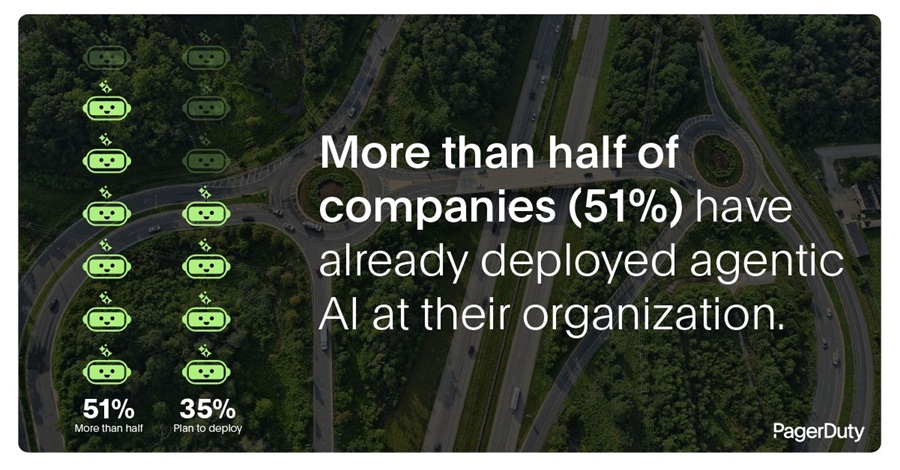
More than half (51%) of companies are already leveraging AI agents, according to the PagerDuty Agentic AI Survey.
Agentic AI adoption is poised to accelerate faster than generative AI (GenAI) while reshaping automation and decision-making across industries. Companies are no longer just experimenting. The survey data shows that 94% of companies believe they will adopt agentic AI more quickly than GenAI, with 55% strongly agreeing that they will integrate it across their organizations at an accelerated pace. As businesses look to automate complex workflows and drive efficiency, agentic AI is emerging as the next phase of AI-driven transformation, offering faster deployment and deeper operational impact.

Key findings include:
Confidence in GenAI
The majority of respondents (63%) have fully integrated GenAI into their company. 73% of organizations in the UK and 69% in Australia lead the charge with 64% in the US not far behind. However, traction in Japan shows to be noticeably slower as only 44% of companies have fully integrated GenAI.
AI Maturity and Adoption
71% of companies that have fully implemented GenAI are far more likely to have already deployed agentic AI, compared to just 19% of companies that have yet to fully implement GenAI.
Strong Return on Investment (ROI) Expectations
62% of companies expect more than 100% ROI from agentic AI, with an average expected return of 171% on their investment. GenAI has already delivered strong financial results, with an average ROI of 152%.
Automating Workflows at Scale
52%, more than half, of companies expect agentic AI to automate or accelerate between 26% and 50% of their workloads, unlocking significant operational efficiencies.
Future Impact of AI
44% of business leaders expect agentic AI to have a greater overall impact than GenAI, while 40% believe the latter will prove more transformative, demonstrating that companies are divided on whether agentic AI will cause an industry shift similar to GenAI.
Lessons from GenAI Implementation
44% of business leaders cite rushed AI adoption without proper planning as the biggest challenge, which is one of the mistakes leaders hope to avoid repeating from their GenAI deployment. Cost control (40%), improved employee training (37%), and stronger data infrastructure (37%) were also among the top priorities for AI strategy refinement.
AI Investment Is Scaling Up
75% of organizations are investing $1 million or more in AI initiatives, reflecting a commitment to long-term AI-driven transformation, showcasing ongoing interest in AI implementation leading to increasing budget allocations.
"Leaders need to provide tangible, quantifiable benefits from their AI deployments if they want to justify the investment," said Eric Johnson, CIO at PagerDuty. "PagerDuty's latest survey data illustrates how strongly organizations believe agentic AI will help unlock real value from AI and automation, as 62% of survey respondents anticipate triple-digit ROI. Companies that successfully integrate agentic AI into their operations can expect increased efficiency gains by automating complexity and accelerating decision-making."
Many organizations learned firsthand that insufficient training hindered GenAI adoption and are taking a different approach with agentic AI. Every company surveyed has various plans to implement agentic AI training, with 61% prioritizing organization-wide seminars or structured initiatives.
Additionally, 56% of organizations will offer an external course to their employees, while 52% plan to host official office hours and formal internal mentorship programs to ensure employees can effectively integrate and leverage AI agents in their workflows.
Methodology: The survey of 1,000 IT and business executives across the US, UK, Australia, and Japan was conducted by Wakefield Research.
